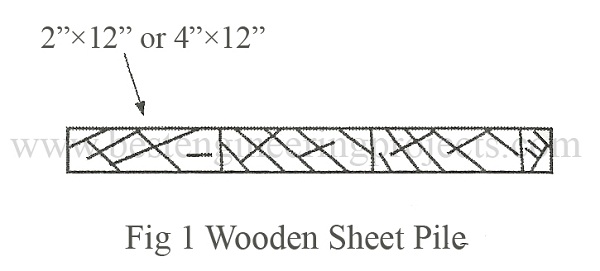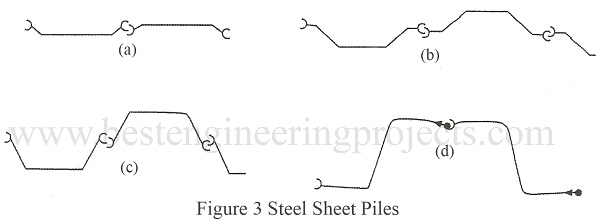A sheet pile wall consists of a series of sheet piles driven side by side into the ground. This results in a continuous vertical wall for the purpose of retaining an earth bank. A sheet pile wall is a flexible wall having negligible weight and weight has no control over the wall stability. The stability is entirely due to the passive resistance developed between the wall and the soil.
Sheet piles wall are generally used for water front structures, temporary construction, lightweight construction, coffer dams, riverbank protection and retaining the sides of excavation Sheet piles wall cannot be used in the strata of gravels and boulders; and for very heavy Walls.
Types of Sheet Pile Walls
Sheet piles are pre-cast members comprising varieties ranging from simple wood planks and light gauge sheet metals to heavy sections made of reinforced concrete and structural steel members.
Timber sheet piles – These are generally used for temporary structures and braced sheeting in excavation works. If it is to be used in permanent structures above water table, some form of preservative treatment shall be given. Even given the preservative treatment the life of timber sheet pile is short, Timber sheet piles are joined by means of tongue and groove joint. Timber piles are not suitable in the strata consisting of gravel and boulders.
Concrete sheet piles – These are pre-cast concrete members usually joined by tongue and groove joints as shown in Fig.2 below. They are relatively heavy and bulky and displace large volume of soil during driving. This large volume displacement increases the driving resistance. Handling and driving should not damage the piles and suitable reinforcement shall have to be provided for this purpose.
Steel sheet piles – Steel sheet piles are the most common types. These piles have several advantages over the other types of piles. Some of the important advantages are:
- It is resistant to high driving stresses developed while driving in hard and rocky material
- It is lighter
- It may be used several times
- It can be used either below or above the water table
- It has longer life
- It has got high salvage value
- Joints suitable for a particular job can be provided so that it does not deform during driving
- The pile length can be increased either by bolting or welding
Steel sheet piles are available in market in several forms. In Fig.3 below, some common types are shown. The deep are webs and Z piles are used where large bending moments are to be resisted as in the case of anchored and cantilever walls. The shallow arc piles can be used where the bending moments to be resisted are less. Straight web sheet piles are used where the web will be subjected to tension as in the case of the cellular cofferdams. The ball socket types of joint offer less resistance to driving as compared to thumb and finger joint.


